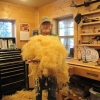The way I sharpen my carving tools is a skill. It's not a mystery! You just need to know clearly what you are looking for, and how to find it ...
I learned this approach to sharpening carving tools - the double bevel - from a superb master carver who was himself taught by a master of the craft - and so on. I have practised, tested and refined it for some 40 years but haven't improved on it. This way of profiling and sharpening my gouges suits me and my style of carving. There are other approaches but if you want to know - succinctly - what I do: Here it is. I hope, in these 2 lessons, to lay out simply for you what you are aiming for and how to get there.
Please study the other videos on this website and my book, Woodcarving Tools, Materials & Equipment vol 1. to expand what I'm offering here and how the theme adapts to different types of gouge.
Power sharpening: I don't deal with it in these videos but, to be clear: There is no moral high ground to sharpening by hand; and if you are a busy carver, you'll want to bring in power to help speed the commissioning or maintaining of your carving tools. But while you are learning? You want to nail the method and really understand what profile or shape you want, and why. Power wheels are fast, remove metal quickly and can alter the shape of your gouge detrimentally before you know it. My experience is that it's better to start slowly by hand and get that understanding in your bones first. Then, whatever you bring in to speed up your sharpening will be firmly under your control; you get the shape and cutting edge you want.
Accompanying Download: For subscribing members, below is my No Fear Sharpening as a PDF. It contains some summaries as well as other advice and thoughts that I hope will help.
Don't be afraid! You can do it.

| 20 December 2024 20:42
Thanks, Chris. The blade is pretty thin in cross section. I'll try a steeper bevel and see if that helps.

| 20 December 2024 19:13
Darrin - Shortbents are tricky!
Remember that when you use them, there's a lot of sideways pressure on the cutting edge as the blade scoops. My guess would be that you are making the cutting angle too shallow. In other words, the wedge of metal at the edge is fragile.
Try presenting the bevel at a higher angle. Don't worry if you end up with a rounded or secondary bevel - that will help scooping through the cut.

| 19 December 2024 18:39
Hi Chris. With the help of your videos and lots of trial and error, I feel I've gotten much better at sharpening. In particular, your advice to constantly check for the white line, vs. mindlessly continuing back and forth on the stone hoping for the best, is key for me. But I'm having a real problem with an old Addis long bent (no.3 sweep). Despite keeping an eye on the line, maintaining a consistent angle on the stone, etc, continuing only til a burr rises, and adding a small inside bevel, the edge fractures either as I'm sharpening or as soon as I make a fresh cut into wood. I'm starting to wonder if maybe a previous owner might have ruined the temper. Would it be a good idea to attempt to retemper it? Many thanks in advance!

| 23 October 2024 08:48
Tony - Sharpening is a bit like tuning a violin. It's not just for the virtuosos, even the most humble beginner has to do it! We all have to learn it. It's also discrete, in that THIS is what the tool should look like; and THIS is how to do it.
It's just a piece of metal at the end of the day. a means to an end: your carving. So, relax, get a couple of tools sharpened properly, and get stuck into that wood!

| 20 October 2024 15:02
Good morning Chris. I've been a subscriber for a few weeks and while I've yet to carve a project (merely doodling at this point), I have spent the the two weeks practicing sharpening. I must say, I've always thought sharpening was something for 'the elect (!)', something mere mortals aspire to. I'm now able to sharpen fairly consistently, something I'd previously wondered if I could achieve. So, thank you for your advice and encouragement. Have a great day!

| 01 February 2024 05:31
Thank you very much! Going to watch all sharpening videos. I have 400 and 1000 grit stones for future sharpening.

| 31 January 2024 09:25
Clarissa - Thing is, the tools ARE the carving.
They are the interface between you, and the wood; the channel through which you express your intentions, even yourself.
So it's more than just an acceptance about sharpening your tools; that's only the first stage. You'll actually come to see sharpening as inseparable from the tools and come to love the joy that a truly sharp tool will give you.

| 30 January 2024 09:31
Thanks for explaining so very well! I got it and I am accepting that a wood carver must learn to sharpen her tools sooner or later.

| 30 January 2024 09:02
Clarissa - Absolutely! Stropping regularly will help maintain the cutting edge.
Couple of things to remember:
1. Don't lift the handle as you strop the outer bevel; that will round over the bevel. Keep that low cutting angle.
2. Nevertheless, you will find the cutting angle rises with time. Because the leather is slightly soft, it will tend to round the bevel, which also makes the 'wedge' of metal thicker, and thus the tool harder work to push into the wood. So keep an eye on this. After a long period of stropping you may have to flatten the bevel.

| 30 January 2024 01:19
Aloha Chris,
Is it possible to simply maintain the sharpness of our tools by constantly stropping before the tool is dull?
Thanks:)

| 13 October 2021 16:55
Imran - Personally, not for me. The way I shape, sharpen and use my carving tools was the way I was taught by my mentor, Gino Masero, when I first started carving and have never been able to improve on it - despite trying!
Having said that, the tools are only a means to an end, so if another carver can produce beautiful work with differently shaped tools, that's great; no comment from me.
And having said THAT, think about this: the reasons we have shortbent (spoon) gouges are twofold: the scoop we need to get into a tight curve; or the handle getting in the way. A microbevel means you have to lift the handle to get the edge to cut the wood - yes? So, following that rabbit: If you need to get deep into the wood and don't have a shortbent, put a very short bevel on the gouge and you'll find you can go deeper. In effect a really short, rounded bevel will turn your gouge into a shortbent.
Actually, don't. I have done this but it's a lot of work, limits the gouge and far better to buy the shortbent gouge you need. See it as a thought-experiment...

| 13 October 2021 00:18
Hi Chris, hope ur keeping well. I have wanted to ask this question since I saw another master carver talk about it in one of their videos. Regarding the outer bevel would there be any instance where a micro/secondary bevel might be useful? Thanks

| 07 February 2020 17:01
Mike - If you look at 'No Fear' 2, you'll see me feeling for the burr around 8:00. It's inevitable that you will create a burr (or 'wire edge') on one side of the cutting edge as you finish up to it on the other. You want to feel for this and remove it with either the bench or slipstone as appropriate. You can't really remove the burr by stropping, which more consolidates the sharp edge. Stropping should follow on once the edge is finished on the stones.
You may also find the white line of the edge, or some part of it, reappears as you start carving; the edge 'toughens up'. You would need to go back to the stones and touch that part up.

| 05 February 2020 14:08
Chris, I don't see any mention about a "burr" and what to do with it. When commissioning tools I understand I shape the tool until I achieve a very small white line at the cutting edge. Then move onto the sharpening stage. Should I be using my slip strops on the outside bevel until I achieve a burr then remove it from the inside bevel and then repeat or do I not worry about the burr and concentrate on stropping both the inside and outside bevels the same amount of strokes?

| 19 December 2019 12:37
Lisi - To me, the way I carve letters, the tools I use and how they are sharpened is the same as all my carving. Incising letters is hardly different from, say, setting in the edge of a leaf so the answer is yes.
And the upshot is that if you can carve lovely letters in wood, you can carve almost anything! So do bear that in mind.
BTW: The long outside bevel makes for a mean 'wedge 'of metal to penetrate the wood; adding the shorter but definite inside bevel strengthens that wedge and gives the tool far more looseness in how the tool handles.

| 19 December 2019 11:47
Hi. Thank your the great information and encouragement. can you just clarify whether a longer outside bevel and an inside bevel is also preferable when the tool is only used for letter carving, ie a high angle dagger grip for slicing actions? Thank you in advance

| 14 July 2019 12:52
Good Morning Chris - it's so helpful to go back and re- view these sessions...my touch has lightened up a lot and I have much more finesse with controlling the sharpening of the tool.. also, I find that I am paying more attention to the burr than the appearance of the metal. I hope I'm on the right track. thanks for this

| 03 February 2019 02:52
Thank you Chris for this pdf, titled "No Fear Sharpening. I have printed the file, placed the printed material into clear plastic protectors, and have stationed it at the bench. Today I placed an order with Norton Abrasives for a truing stone for the bench stones, slip stones and rouge for the strop. Again I thank you for the most informative material addressing the art of carving.
Charles

| 18 January 2018 17:49
David - I found the coarse grade good for cleaning up the shaping (grinding) stage of commissioning but the fine grade too fine for the final sharpening stage. The translucent Arkasas is 'just right' for the finishing and since I am using oil, I use an oil-based coarse stone for the previous work. You can't have any oil whatsoever on a ceramic stone, so I don't recommend mixing the two anyway.
Also, there is a very poor selection of ceramic slipstones available.

| 12 January 2018 16:29
Chris, what is your opinion of the ceramic sharping stones?

| 28 March 2017 11:01
Azucena - A rounded bevel, which gives you a higher angle at which the edge cuts into the word, is a common problem! You are raising and lowering the handle as you move the blade from one side of the benchstone to the other. Try and lock your elbow into your body as you move your weight from side to side, thus keeping the same angle of presentation to the stone's surface.
Try coating the bevel with black ink from a marker pen; you'll see exactly which part of the bevel is in contact with the stone. A little rounding n the bevel won't matter as long as the tool cuts the wood at a low angle.
If your grinding wheel is flat and the blade is at right angles to the direction of rotation (or using a belt grinder), then you can get a flat bevel - but only, again, if you keep the handle at a constant angle.
There's a lot to take on when you start sharpening but it all becomes easier with practice! It does seem that you can be quite accurate so just keep going and you'll be fine!

| 28 March 2017 02:52
Hi Chris - I'm having a bit of a time trying to sharpen my tools. Mainly, my outer bevels always end up slightly rounded. I've been able to flatten them out by taking a small flat sharpening stone and carefully taking down the middle high spot under a magnifying lamp. Have you found, in your experience, that it's easier to achieve flat outside bevels when using a grinder? Any advice would be appreciated, thank you!
Azucena

| 25 March 2017 07:40
Albert - The type of handle is not important as such; I sharpen the few palm tools I have in the save way as my regular gouges.
However, the thinness of the metal though is something to think about:
Flexcut tools for example have quite thin blades relative to more conventionally made carving tools. What it means is that, with an inside bevel and offering the outside bevel to a benchstone at 15-20, both bevels will be short - not much is needed before meeting at the cutting edge. The whole wedge of metal made by the bevels is smaller and thus the tool needs less effort to push it t through the wood.
The thing to convince yourself about is the importance of that inside bevel. You could take one tool and just experiment?

| 25 March 2017 01:31
One last question Chris: Should palm tools have inside bevels? One of my carving friends indicated that the metal would become too thin if an inside bevel was applied. Thus only an outside bevel should be used on palms tools. Al

| 19 March 2017 20:52
Albert - The fact is, you'll remove the same amount of metal to get to the end result whether you square off the edge first for go straight to the levels.
I like to square the edge because I am more accurate, more uniform, in what I do, and thus the result. But you ca go straight tot he bevels.
It also forces me to put in a lot of inside bevel, which thins that squared off edge quickly. Try it both ways and see why you think?

| 19 March 2017 00:14
Chris - When commissioning a new tool, do you always start from the beginning of the sharpening cycle or can you start setting the inside and outside bevels without touching the cutting face. Al

| 16 March 2017 08:05
Albert - I have my grinder set on a shelf much higher than normal (bench height); somewhere so when I stand I am looking down around 30-40 degrees to the wheel. I ca see and manipulate the tool much better. Your eyes are nearer the wheel now so don't forget the eye protection!
'Burnout'? There's a lesson here on how to prevent tools turning blue: Videos > Sharpening > When the Edge Turns Blue

| 15 March 2017 13:19
Thanks Chris for the quick reply and good information. I will practice more as you suggest in your videos and focus more on the tool position to reduce the number of planes or bevels. Is there any recommended heights for the grinding system or the stone position (table height) in relation to the body to better control the tool position? I must note, that I have used your method for sharping my V-tools. I'm gaining more confidence and been able to get a cutting edge without burnouts. I'll keep working.

| 14 March 2017 20:44
Albert - You have to visualise the cutting angle on the grinder, then keep putting the tool back at this angle. Feel it with your body ad remember the position of your hands as well as what your mind indicates. Experience - doing a lot of it - is, of course, really helpful here. Just keep at it and it'll come.
Here's another thought: suppose someone (not me!) was to offer you a hundred dollars for every time you offered the tool correctly to the grinding wheel... You'd soon be good at it!

| 14 March 2017 18:25
Chris my question is this: I understand what a single plan bevel is but how do you place the tool back on the same plan when you remove it from the grinder to check the grind position. As a result, I get several plans. Al Hamilton, March 14, 2017

| 20 February 2017 20:41
Thank you for your help! I will do as you advise.

| 20 February 2017 18:02
Liam - The long outside bevel gives you a low cutting angle, which makes for a more acute wedge behind the bevel, easier to push through wood and a good hand position. The inner bevel counters the inherent weakness of the long bevel.
Me? I'd keep the longer bevel (15-20deg), get the slipstone and add the inside bevel.

| 19 February 2017 22:38
Thanks for your reply!
You say that I do need to keep the outside bevel long - is this as necessary on such a small tool, since it cuts such a small amount of wood? Should I try making the outside bevel shorter first before purchasing a slipstone for an inside bevel?
Thanks again,
Liam

| 19 February 2017 11:00
Liam - It's rare that a gouge of a reputable make is defective because of the steel or tempering, so let's go for the sharpening.
If the edge is crumbling, it's too weak for the work you are doing with it, or the hardness of the wood. Perhaps you are making the outside bevel too long, too low? If you want to keep the outside bevel long, and you really do, then you need to buttress it with a bevel on the inside - getting a bigger 'inclusive' bevel angle at the edge by combining both inner and outer, rather than just having the single outer. Hope you are with me! So, add a significant inner bevel.
Sharpening small tools is tricky, a little movement of the hand makes for a big effect, and it's easy to weaken or remove the corners. Have a look how you are doing with a magnifier? and work slowly and precisely.
Slipstones: You can buy fine Arkansas and carborundum slipstones that have the traditional tapered section: fat on one side, narrow on the other, fairly reading. You can re-shape that narrow edge to fit and create the inside bevel of your #9 ...

| 17 February 2017 21:30
Hello Mr. Pye,
I have a #9/3mm gouge that I have been having trouble sharpening. I have had it for about a year, and the edge has gotten nicked a few times, but I have been able to re-sharpen it just fine every time. However, just recently I saw that it had another nick in the edge (I have no idea from what). But for whatever reason, I can't seem to get it completely sharpened without the edge crumbling. When I first bought the tool, I purchased a fine slipstone which I shaped with sandpaper to the right profile. But lately I have stopped using it because I couldn't get the correct shape for the slipstone. Instead, I have simply been sharpening the outside bevel until the white line had mostly disappeared, and then removing the burr with the shoelace strop that you use for your veiners. But I can't seem to get the white line to completely disappear without the edge of the tool crumbling, and today when I tried to re-square the edge again, one of the corners just began crumbling apart, and I have no idea why.
So, do you know why this tool is doing this? It wasn't a cheap tool, and I have several others of the same brand that are great tools, but do you think this one is defective? I have only been using my Arkansas stone for this tool since I am only touching up the edge; should I try starting with the coarse stone instead and then go to the Arkansas? Is it also possible that this tool needs an inside bevel? I would do it, but I can't find any slipstones that are only 3mm.
I apologize for the length of my question, and I hope it isn't confusing!
Thanks in advance,
Liam

| 26 January 2017 10:53
Karen - It does take a while to build up the shine over the whole of the bevel. And' whole' is the operative word here: have a look ant the bevel and if that shine is towards the edge only, then you would be holding the handle too high and rounding over the bevel. Just wanted to say that - I should have mentioned it in the video. And, of course,I might be pressing harder than you as well.
Back to the honing compound: the easiest way of making it is to buy one of those hard polishing blocks and cut it with something a bit softer: suet or tallow (which you can find online), by melting together. Say 1/3 the softer. The blocks, which are to all intents and purposes the same thing, are designed for high speed wheels and don't stick too well to the flat leather unless softened like that.
Otherwise, when you have your melt going, you can add any abrasive to hand. In the past I've added jeweller's rouge, 600grit carborundum paste, diamond paste - probably everything except some garden herbs...

| 22 January 2017 16:51
Chris I'm still at it, commissioning, 3rd tool. Believe it or not I found the flatter gouge the harder to commission. Finally I realized that my Arkansas stone was not aggressive enough and yes it has taken time but I have learned a great deal in the process. In one of your videos I think you mentioned it but can you say again the mixture you use for sharpening paste for strop. My tools don't shine like mirrors the way yours do and yes I stropped 50 times!

| 06 November 2016 22:08
AnnKristin - My heartfelt advice is that one should always buy the best tools one can afford, even if that means just a single tool to start with.
Beginners have enough on their plates without having to work with poor tools, or poor wood for that matter.
Have a look at the beginner's course: there are 3 tools recommended. I suggest you start with one of these, perhaps the middle gouge. You can do a lot of carving with just this one tool. Have fun and see what you can doit it - enjoy! Learn to sharpen it. Then add a second tool and so on.

| 06 November 2016 17:59
I haven't bought the gouges yet, I have only carved with exchangeable blades since I never managed to learn sharpening my carving knives. But now I'm hopeful I will learn thanks to your online workshop. But I guess it will take time for me to learn. I wonder if it is a wise idea to buy a cheap gouge just for learning sharpening, since I am retired and have to think about every money I spend.
AnnKristin

| 29 June 2016 02:22
Thanks for the encouragement... and thanks for all your help!
Liam

| 28 June 2016 11:38
Liam- There are lots of things in this world to be nervous about - don't make your carving tools one of them! Seriously though, it's common for inexperienced carvers to worry about their tools, especially having to repeat any sharpening. If you have sharpened your gouges correctly with a strengthening inside bevel, don't lever the edge when it's buried in the wood and don't run into hidden nails then you shouldn't be damaging the edge and all you really need is maintenance stropping. Yes, experience will really help you feel confident. Remember, att the end of the day, it's just a piece of metal...

| 23 June 2016 22:57
Hello Mr. Pye,
I often find myself afraid to use my tools in certain ways (i.e., on end grain, or with a mallet) for fear of nicking the edge and then having to re-sharpen them... I would assume this is (to some extent) normal for inexperienced carvers to feel this way? I would also assume that the more I carve, this nervousness will go away, or at least lessen?
Thank you,
Liam

| 14 April 2016 14:51
Penny - Yes, the same method really. A tool that has no shoulder must be used more delicately that one with a shoulder:e the tang (the bit that fits into the handle) will tend to drive into the handle and split it. For this reason you ant to make sure the end of the tang is squared off, blunt, and never used a mallet!

| 11 April 2016 22:25
Chris, The 2 tools I'm having problems with have no tag or shoulder. The metal shank fits over the wood handle however it isn't tight. Should I use the same method?

| 11 April 2016 22:11
Thank you, my husband has a small saw mill, fine sawdust and shavings are plentiful here.

| 11 April 2016 19:47
Penny - Well done for rescuing and reviving these old carving tools! If you put 'handles' into the search box (top left of page) you should get a video on removing blades from handles and resetting them. The important part is how you hold the blade to put the handle back on - no doubt it'll come off very easily! You need to pack the hole in the handle with fine sawdust, shavings, splinters of wood - that sort of thing first - this should be enough to grip the tang snugly again. You could glue the handle in with 2-part epoxy resin: Fill the hole as best you can with the glue, set in the tang and align the blade properly and leave to go hard. The only downside of this method is you will need to split and lose the handle if you ever want to change it again.

| 08 April 2016 01:25
Chris,
Even though I probably don't need any more gouges, I love searching for used gouges at flea markets. I always feel like I have found a treasure when I find a good quality tool! I resharpen them and add them to my tools. However, I have bought 2 gouges, both say Hudson on them, that the wood handle has separated from the metal gouge. I can't figure out how to reattach the handle so it doesn't come back apart. I have considered putting a screw though the metal into the wood handle. Any suggestions?

| 20 March 2016 17:39
Justin - It's important to think of the cutting end of a gouge, with its inner and outer bevels - as nothing more than a glorified wedge of metal. The longer the outer bevel, ie. setting a more acute angle by a 'long grind', the sharper but the more delicate it is. No question. This is where the inside bevel comes in: it strengthens the cutting edge by adding its angle to that of the outside bevel while at the same time, being short, still lets the tool enter the wood easily. It's in the book, though Hasluck doesn't explain it - p.51: "The slips should now be applied to the inside of the gouges, so as to obtain the cutting edge nearer to the centre of the thickness of the tool." At the end of the day, we are seeking to find a balance between strength and ease of penetrating wood. When you've been sharpening and carving for a while you'll get a feel for it. Just remember, there's lots of metal in a carving gouge for you to play with, adjusting the inner and outer bevels and learning by experience.

| 19 March 2016 08:32
Chris, I was reading through the "Manual of Traditional Wood Carving," by Paul Hasluck, published in 1911. Concerning the outside bevel, it comes from the factory with a short grind, which you change to a long grind. The book says, "It is sometimes thought that a carving tool necessarily requires a very long 'grind.' But, although for light modelling this is more or less so, for general work this is a mistake, because a tool so ground, if used for setting in, is liable to have its edge suddenly snapped off." (pg. 48) I thought this was curious, and wondered what your thoughts were and if you'd ever seen that happen? The book is quite old, so many this doesn't matter anymore.

| 12 September 2015 17:22
Mark - Thanks for your comment about the price increase. We'll always try to keep it as low as we can and not compromise on what we give in exchange. It's not a dumb question but I think the answer is that you will just know when you've commissioned your carving tool and there is no more to be done. I've laid out definite, objective criteria here which you can meet, and the proof of the pudding etc. Give it a go with one of your carving tools: step be step, and you'll see.

| 27 August 2015 02:54
Chris, I have a question on sharpening (maybe a dumb question) How do you know when enough is enough what I mean is how to tell when you have sharpened the tool all that it will sharpen. By the way I think your increase in price is well worth it & reasonable with what I've learned so far from your expertise
Mark Prewitt

| 05 May 2015 09:08
Your right, I think I'm guilty of not putting enough inside bevel on the blade. Thanks for your help and encouragement. I'm going to work on that gouge tonight. :)

| 04 May 2015 14:24
Neal - Ouch! It's an awful feeling when that happens. Luckily it's not the end of the world and we can resharpen. The commonest ways of snapping a blade (usually a corner) is to lever the tool when it's buried in the wood; or, in the case of a U-shaped gouge. driving it into wood so the sides are pushed together by the bevels. But obviously that's not what you are talking about, since you are mentioning only 'light taps'. So it must be the wedge of metal itself that makes up the cutting end: it'll be too acute an angle and therefore weak - bearing in mind that we carvers 'scoop' our cuts so there is some sideways pressure. So, either you have the outer bevel too long (ie too low); or, not enough inner bevel. Both bevels make up the overall angle, the 'wedge' that is the cutting end. And my guess, because you are a newcomer to this, is that you've not enough inner bevel. Most beginners put on too little inside bevel, just a few scratches - you should readily feel it. I suggest you leave the outer bevel and resharpen the tool from the inside - in other words, add a lot of inside bevel (at 5-10 degrees) until you get rid of the white line of the cutting edge then finish off both sides on a fine stone. See what happens! You could well be in for a big learning event...

| 30 April 2015 18:01
Hi Chris, I've been commissioning all my new and second hand gouges as you recommend, and am thrilled to say I think I'm finally getting somewhere with them. At least I thought I was, just picked up a 8 sweep 1 inch gouge, a couple of light hits with a mallet and to my surprise a great big chunk of the blade snapped off, I'm talking 10mm across and 3mm deep. Have I potentially made my bevel too long and gone too thin, or is this a fault with the tool? I won't say who made the tool, but it wasn't one of the cheap ones. Thanks

| 27 December 2014 15:07
Duncan - Yes, you've got it. When someone makes the mental leap from 'sharp carving tool' to 'glorified wedge', they'll begin to understand why a keen cutting edge is only part of what makes a carving tool perform well.

| 26 December 2014 14:28
Hi Chris, on the subject of inside bevels, would I be right in thinking that we need the inside bevel to compensate for having changed the outer bevel to get the low cutting angle? In effect we are maintaining the angle of the wedge (the angle between the two bevels). In engineering, we adjust the tool angles to stop the cut/crack running ahead of the tool tip which gives us the cleanest cut for that material. But wood is endlessly variable so craftsmen have discovered a wedge angle that adapts to most of the situations we meet. Intuitively we then change the wedge angle when we hit tough wood or cut across the grain by slicing or cutting on the skew. I accept without question a craftsman's experience but my mind just loves to understand the why. Duncan

| 11 November 2014 19:52
Michael - I'm really glad to hear you are really biting into your carving now. I wish you all the best! I keep the corners on my tools because I USE them - a bit like curved knives really - and the squareness I keep because it helps with setting in. So that's the edge shape I want as a rule. However, it's a bit of work to grind back a square edge and resharpen so you need to ask a question: Can you get the gouges to do what you want them to do with their edges being a little 'nosed' (the term for what you describe). If you can, there's no problem, and there is no need to do anything; through perhaps the next time you visit the stone you could creep the edge back more square, which can be done by increasing the inside bevel. Same with corners: it really doesn't matter if the corners are missing in a wide sculpture gouge if you never need them - there isn'y any problem! So, give the gouges a go, see what happens and decide whether they do the job or actually squarer would be better - in which case ...

| 07 November 2014 09:07
If only I had been able to learn from you the proper sequence and process to commission tools 30 years ago! A few thicker stones and bit longer gouges today in the carving kit, no doubt. I arrived at virtually the same principles the hard way...
Thank you for an incredible learning opportunity through this amazing medium. It is a rare person who does something so well and can also teach it.
Thanks to you I am moving from low relief into the round and have a question. My larger gouges have a slight radius (plan view) with corners slightly in back of the leading edge, perhaps 1/8" on a 1.5" width tool, should these be ground strictly straight across?

| 23 April 2014 00:13
Never mind you answered this question under Pye-Cosman DVD x9 Sharpening 8.

| 22 April 2014 09:09
Chris,
Great video's on sharpening by the way. About the inside bevel, I'm not sure if I missed whether you already have addressed this question but do you put an inside bevel on all of your tools? Do you stop putting inside bevels at #10s or #11s? What about v-tools? My apologies in advance if this is a dumb question.

| 19 April 2014 14:22
As someone who has "gone through all" the fear and trepidation stages that Chris describes, I can fully appreciate his points. All are critical, as I know from making all the mistakes. Based on my progress over the last year, two points stood out. Both deal with the inside bevel. I realized, watching the video, that I have been putting my inside bevel on AFTER the outside bevel, not before. Now I realize that by doing that, I have inadvertently been shortening the nice low angle I had made on my outside bevel. Second, I realize, again, that my inside bevels are not long enough. Lastly, I keyed in on Chris's comment about picking one chisel to learn on and get it right. I have my "favorite" chisels... and use them often... and guess which ones they are? The correctly sharpened ones. The others frustrate me and I need to take the time to "do it right". Great details in the video. Really helps.

| 19 April 2014 13:56
Chris - of course you're right on target on all points. I have to say, having "discussed" this with you in the recent past, that it helped me a lot to actually impose upon myself the obbligation to use only a limited number of tools on a part of a sculpture that I was working on until I felt more and more confident that I was keeping those tools sharp and usable. From there, having gained confidence, I've kept moving ahead!